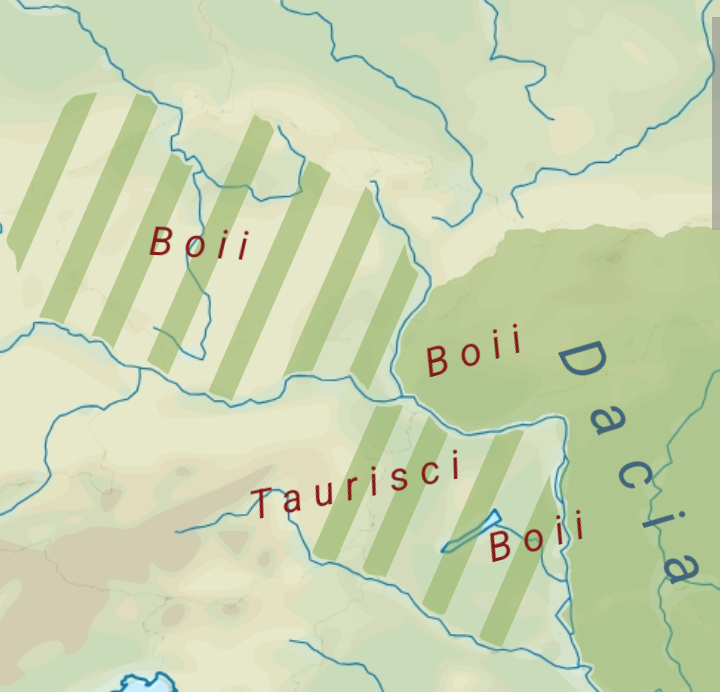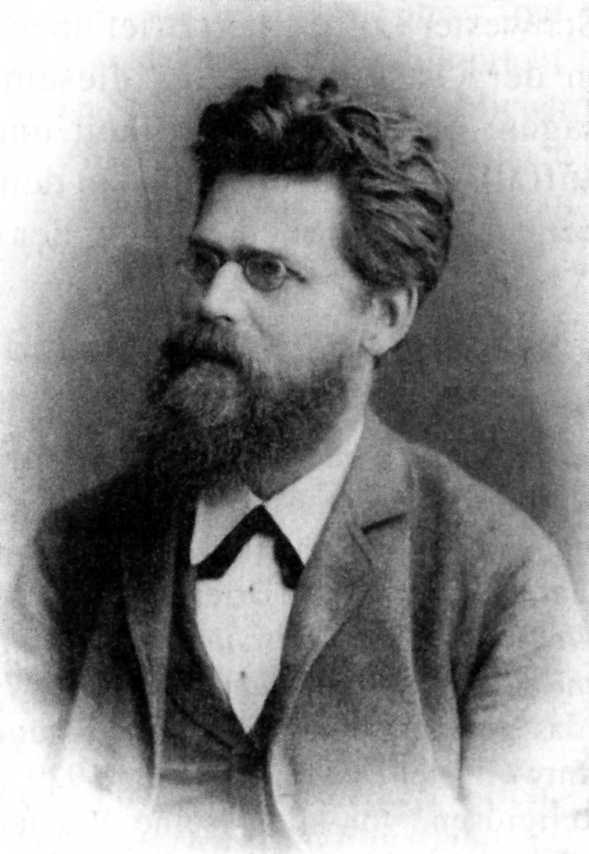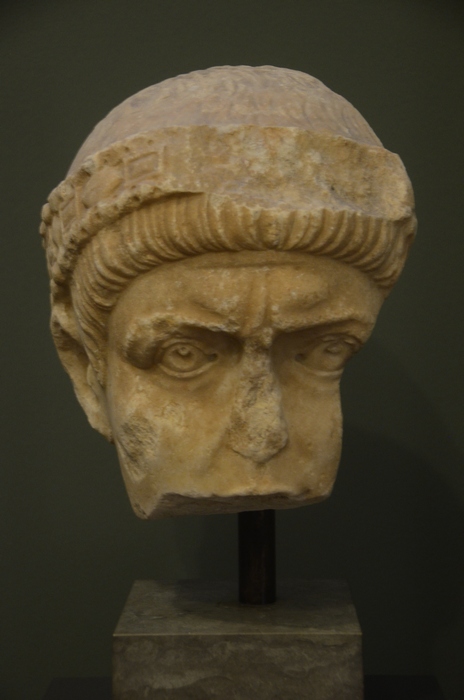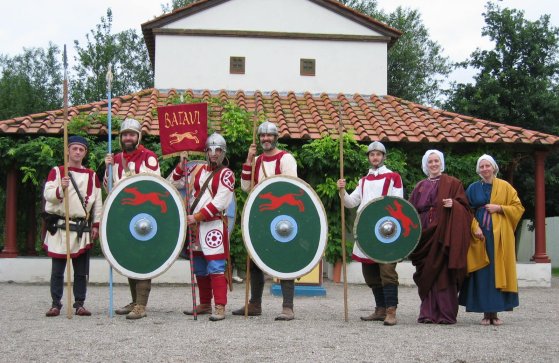|
Lucillianus (magister Equitum)
Lucillianus ( 350–363 AD) was a high-ranking Roman army officer and father-in-law of the emperor Jovian. He fought with success in the war against Persia, and played a part in the execution of the emperor Constantius II's cousin, Gallus. In 361, Lucillianus was kidnapped by the emperor Julian and forced into retirement. He was recalled to service after the accession of his son-in-law Jovian in 363, and given a senior military command, only to be murdered that same year by mutinous troops in Gaul. Biography Career under Constantius II Lucillianus was the father of Charito, wife of the Roman emperor Jovian (). He probably, like Jovian, came from the province of Pannonia. His hometown may have been Sirmium, Moesia Superior, where he was once stationed and later resided during his retirement. In 350, the emperor Constantius II () gave Lucillianus command of the war against the Sasanian Empire, and, in this capacity, he successfully defended the fortress of Nisibis against Persi ... [...More Info...] [...Related Items...] OR: [Wikipedia] [Google] [Baidu] |
Pannonia
Pannonia (, ) was a Roman province, province of the Roman Empire bounded on the north and east by the Danube, on the west by Noricum and upper Roman Italy, Italy, and on the southward by Dalmatia (Roman province), Dalmatia and upper Moesia. It included the modern regions western Hungary, western Slovakia, eastern Austria, northern Croatia, north-western Serbia, northern Slovenia, and northern Bosnia and Herzegovina. Background In the Early Iron Age, Transdanubia was inhabited by the Pannonians or Pannonii, a collection of Illyrians, Illyrian tribes. The Celts invaded in the Late Iron Age and Gallo-Roman culture, Gallo-Roman historian Pompeius Trogus writes that the Celts were met with heavy resistance from the locals and were not able to overrun the southern part of Transdanubia. Some tribes advanced as far as Delphi, with the Scordisci settling in Syrmia (279 BC) upon being forced to withdraw. The arrival of the Celts in Transdanubia disrupted the flow of amber from the Balti ... [...More Info...] [...Related Items...] OR: [Wikipedia] [Google] [Baidu] |
Procopius (usurper)
Procopius (; Ancient Greek: Προκόπιος; July 325 – 27 May 366) was a Roman usurper against Valens. Life Procopius was born in July 325, in Corycus, Cilicia (now Turkey). On his mother's side, Procopius was a maternal cousin to Emperor Julian, since their maternal grandfather was Julius Julianus. His first wife was probably Artemisia. The Roman general of the 5th century Procopius and his son, the Emperor Anthemius, were among his descendants, the first being the son of his son Procopius. During the reign of Constantius II, he served as ''tribunus et notarius'' for a long period of time. By 358, the emperor trusted him enough to send him with Lucillianus as an envoy to the Sassanid court. His career granted him the opportunity to build many important connections, as well as to help him understand the structure of the imperial government. Persian campaign When Julian departed from Constantinople in the spring of 362, his objective was clear: to launch a swift, ... [...More Info...] [...Related Items...] OR: [Wikipedia] [Google] [Baidu] |
Realencyclopädie Der Classischen Altertumswissenschaft
The Pauly encyclopedias or the Pauly-Wissowa family of encyclopedias, are a set of related encyclopedias on Greco-Roman world, Greco-Roman classical studies, topics and scholarship. The first of these, or (1839–1852), was begun by compiler August Pauly. Other encyclopedias in the set include ''Pauly–Wissowa'' (1890–1978), ''Little Pauly'' (1964–1975), and ''The New Pauly'' (1996–2012). Ur-Pauly The first edition was the ("Practical Encyclopedia of the Study of Classical Ancient History in Alphabetical Order") originally compiled by August Friedrich Pauly. As the basis for the subsequent PaulyWissowa edition, it is also known as the . The first volume was published in 1839 but Pauly died in 1845 before the last was completed. Christian Waltz (18021857) and Wilhelm Siegmund Teuffel completed the 6 volume first edition in 1852. A second edition of the first volume of Pauly's encyclopedia was published by Teuffel in 1861. The revised second volume came out in 1866, wit ... [...More Info...] [...Related Items...] OR: [Wikipedia] [Google] [Baidu] |
Otto Seeck
Otto Karl Seeck (2 February 1850 – 29 June 1921) was a German classical historian who is perhaps best known for his work on the decline of the ancient world. He was born in Riga. Life and career He first began studying chemistry at the University of Dorpat but transferred to the University of Berlin to study classical history under Theodor Mommsen. Seeck earned his doctorate from the University of Berlin in 1872 after writing his thesis on the '' Notitia Dignitatum'', a document enumerating the roles and responsibilities of administrative officials of the later Roman Empire c. 400 AD. He habilitated under Mommsen in Berlin in 1877 and, with the help of Mommsen, secured a post at the University of Greifswald in 1881, where he taught Roman History and Archaeology. There he met Karl Julius Beloch. In 1907 he went to the University of Münster where he continued teaching and writing. Seeck wrote many influential works on late antiquity Late antiquity marks the period th ... [...More Info...] [...Related Items...] OR: [Wikipedia] [Google] [Baidu] |
Valentinian I
Valentinian I (; 32117 November 375), also known as Valentinian the Great, was Roman emperor from 364 to 375. He ruled the Western Roman Empire, Western half of the empire, while his brother Valens ruled the Byzantine Empire, East. During his reign, he fought successfully against the Alamanni, Quadi, and Sarmatians, strengthening the border fortifications and conducting campaigns across the Rhine and Danube. His general Count Theodosius, Theodosius defeated a revolt in Africa (Roman province), Africa and the Great Conspiracy, a coordinated assault on Roman Britain by Picts, Scoti, and Saxons. Valentinian founded the Valentinian dynasty, with his sons Gratian and Valentinian II succeeding him in the western half of the empire. Early life Valentinian was born in 321 at Cibalae (now Vinkovci, Croatia) in southern Pannonia into a family of Illyro-Roman origin. Valentinian and his younger brother Valens were the sons of Gratianus Funarius, Gratianus (nicknamed Funarius), a military ... [...More Info...] [...Related Items...] OR: [Wikipedia] [Google] [Baidu] |
Batavi (military Unit)
The ''Batavi'' was an ''auxilia palatina'' (infantry) unit of the late Roman army, active between the 4th and the 5th century. It was composed by 500 soldiers and was the heir of those ethnic groups that were initially used as auxiliary units of the Roman army and later integrated in the Roman Empire after the ''Constitutio Antoniniana''. Their name was derived from the people of the Batavi (ancient people), Batavi. In the sources they are usually recorded together with the ''Heruli (military unit), Heruli'', and it is probable the two units fought together. At the beginning of the 5th century two related units are attested, the ''Batavi seniores'' and the ''Batavi iuniores''. History ''Batavi'' The ''Batavi'' belonged to the army of the emperor Julian (emperor), Julian, and fought in the Battle of Strasbourg (357). Deployed in the second line, together with the ''Regii'', the ''Batavi'' sustained the assault of the outnumbering Alamannic infantry, which had broken the Rom ... [...More Info...] [...Related Items...] OR: [Wikipedia] [Google] [Baidu] |
Gallia Belgica
Gallia Belgica ("Belgic Gaul") was a Roman province, province of the Roman Empire located in the north-eastern part of Roman Gaul, in what is today primarily northern France, Belgium, and Luxembourg, along with parts of the Netherlands and Germany. Before the Roman province came into existence in about 50 BC, the region was conquered by Julius Caesar during his Gallic Wars. His report, the ''Commentarii de Bello Gallico'', described Belgic Gaul as one of the three parts of Gaul (Tres Galliæ), the other two being Gallia Aquitania and Gallia Lugdunensis. Belgica stretched from the Marne River, Marne and Seine rivers, which Caesar described as a cultural boundary between the Belgae and the Celts, Celtic Gauls. In the north and east it stretched all the way to the Rhine. The official Roman province of this name was later created by emperor Augustus in 22 BC, and named after the Belgae, as the largest tribal confederation in the area. However, it also included the territories of the T ... [...More Info...] [...Related Items...] OR: [Wikipedia] [Google] [Baidu] |
Jovinus (consul)
Flavius Jovinus () was a Roman general and consul of the Western Roman Empire. He was of Gallic or Germanic origin and was both born and buried in Durocortorum, modern day Reims. Biography Jovinus first appears in the historical record as an officer of unspecified rank in emperor Julian's army. He, along with one other officer, commanded the one-third of Julian's army sent into Italy from Gaul. Later during the same campaign he was promoted to the rank of ''magister equitum'' and besieged Aquileia until the war's end. After the war, he was one of the judges at the Trials of Chalcedon. When emperor Julian invaded the Persian Empire, he left Jovinus in Gaul. Julian died on the Persian campaign, and his successor, Jovian, tried to oust Jovinus because he feared his popularity with the troops could allow him to usurp imperial power. However, Jovian's appointee declined the promotion, and then Lucillianus, another officer, decided to go to Gaul and take up the position. Contempo ... [...More Info...] [...Related Items...] OR: [Wikipedia] [Google] [Baidu] |
Praetorian Prefecture Of Gaul
The Praetorian Prefecture of Gaul () was one of four large praetorian prefecture, prefectures into which the Late Roman Empire was divided in the 4th century. History The prefecture was established after the death of Constantine I in 337, when the empire was split up among his sons and Constantine II (emperor), Constantine II received the rule of the western provinces, with a praetorian prefect as his chief aide. The prefecture comprised not only Roman Gaul, Gaul, but also of Roman Britain, Hispania, Spain, and Mauretania Tingitana in Africa (Roman province), Africa Proconsulare. Its territory overlapped considerably with what was once controlled by the short-lived Gallic Empire in the 260s. After the permanent partition of the Empire in 395 into West and East spheres of control, the prefecture of Gaul continued to belong to the Western Roman Empire. ''Augusta Treverorum'' (present-day Trier in Germany) served as the prefecture's seat until 407 (or, according to other estimate ... [...More Info...] [...Related Items...] OR: [Wikipedia] [Google] [Baidu] |
Mediolanum
Mediolanum, the ancient city where Milan now stands, was originally an Insubres, Insubrian city, but afterwards became an important Ancient Rome, Roman city in Northern Italy. The city was settled by a Celts, Celtic tribe belonging to the Insubres group and belonging to the Golasecca culture under the name Medhelanon around 590 BC, conquered by the Ancient Rome, Romans in 222 BC, who Latinisation of names, Latinized the name of the city into Mediolanum, and developed into a key centre of Western Christianity and informal capital of the Western Roman Empire. It declined under the ravages of the Gothic War (535–552), Gothic War, its capture by the Lombards in 569, and their decision to make Ticinum the capital of their Kingdom of Italy (Lombard), Kingdom of Italy. During the Principate the population was 40,000 in AD 200; when the city became capital of the Western Roman Empire under emperor Maximian (r. 286–305), the population rose to 100,000 people and thus Milan became o ... [...More Info...] [...Related Items...] OR: [Wikipedia] [Google] [Baidu] |
Praetorian Prefecture Of Italy
The praetorian prefecture of Italy (, in its full form (until 356) ) was one of four praetorian prefectures into which the Late Roman Empire was divided since the first half of the 4th century. It comprised the Italian peninsula, the western Balkans, the upper Danube, Danubian provinces and parts of North Africa. The Prefecture's seat moved from Rome to Mediolanum, Milan and finally, Ravenna. It existed during the Later Roman Empire, and was part of the Western Roman Empire. The prefecture continued to function within Odoacer's and Ostrogothic Kingdom, Ostrogothic kingdoms, and later within the Byzantine Empire, up to 584, when it was reorganized into the Exarchate of Ravenna. Structure and history The prefecture was established in the division of the Empire after the death of Constantine the Great in 337, and was made up of Roman diocese, dioceses. Initially these were the Diocese of Africa, the Roman Italy#Diocletian re-organization, Diocese of Italy, the Diocese of Pannonia, th ... [...More Info...] [...Related Items...] OR: [Wikipedia] [Google] [Baidu] |





